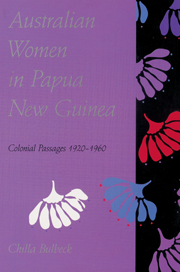Book contents
- Frontmatter
- Contents
- Photographs
- Acknowledgements
- Maps of Papua New Guinea
- Abbreviations
- Introduction
- 1 Passages to Papua New Guinea
- 2 Different Destinations
- 3 White Women in Papua New Guinea: Relative Creatures?
- 4 In Town and Down the Road
- 5 War, a Watershed in Race Relations?
- 6 The Civilising Mission
- 7 Matters of Sex
- 8 Making a Space for Women
- Appendix 1 Biographical Notes
- Appendix 2 Key Events in Chronological Order
- Notes
- Bibliography
- Glossary
- Index
5 - War, a Watershed in Race Relations?
Published online by Cambridge University Press: 22 August 2009
- Frontmatter
- Contents
- Photographs
- Acknowledgements
- Maps of Papua New Guinea
- Abbreviations
- Introduction
- 1 Passages to Papua New Guinea
- 2 Different Destinations
- 3 White Women in Papua New Guinea: Relative Creatures?
- 4 In Town and Down the Road
- 5 War, a Watershed in Race Relations?
- 6 The Civilising Mission
- 7 Matters of Sex
- 8 Making a Space for Women
- Appendix 1 Biographical Notes
- Appendix 2 Key Events in Chronological Order
- Notes
- Bibliography
- Glossary
- Index
Summary
A number of commentators emphasise the pervasiveness of place as a metaphor of racial distinction in colonial societies. Race relations could be harmonious as long as the subordinate group ‘stayed in their place’. Another strain of the argument focussed on the need to ‘keep’ the ‘native’ in his place, and to immediately correct ‘cheeky niggers’. Thus ‘In the Manichean world of the coloniser and the colonised, of the master and the slave, distance tends to become absolute and qualitative rather than relative and quantitative’. Not only is a subordinate place identified in terms of spatial arrangements, it is reinforced by rules and laws governing incredibly trivial elements of conduct, dress and language. These rules are underscored by power, the power to shoot or imprison or punish. Conquest and control by law and superior means of force stand scarcely concealed behind the patterns of interaction that develop between the two caste-like groups. Both in ideology and the Territory, Papua New Guineans and white women had a place: a place defined in opposition to that of white men. But because both these groups were defined as different from white men, and yet not the same as each other, there were contradictions in the placement of these subordinate groups, as Chapters 7 and 8 explore. This chapter addresses the substructure of imperialist ideology, the use of force and the regulation of land and labour, particularly in the pre-war period.
- Type
- Chapter
- Information
- Australian Women in Papua New GuineaColonial Passages 1920–1960, pp. 133 - 163Publisher: Cambridge University PressPrint publication year: 1992



